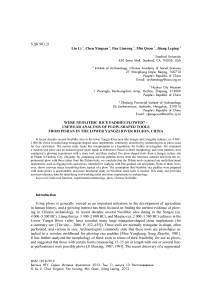Were Neolithic rice paddies plowed? – usewear analysis of plow-shaped tools from Pishan in the lower Yangzi river region, china
Автор: Liu Li, Chen Xingcan, Pan Linrong, Min Quan, Jiang Leping
Журнал: Вестник Новосибирского государственного университета. Серия: История, филология @historyphilology
Рубрика: Исследования
Статья в выпуске: 10 т.11, 2012 года.
Бесплатный доступ
In recent decades several Neolithic sites in the lower Yangzi River area (the Songze and Liangzhu cultures; ca. 4 000– 2 000 BC) have revealed large triangular-shaped stone implements, commonly described by archaeologists as plows used for rice cultivation. The current study treats this interpretation as a hypothesis for further investigation. We examined a modern iron plow and an archaeological stone spade as references, based on their morphology and wear patterns, next conducted a plowing experiment with a stone tool, and then studied five plow-shaped tools from a Songze culture site at Pishan in Huzhou City, Zhejiang. By comparing usewear patterns drawn from the reference samples and from the experimental plow with those taken from the Pishan tools, we conclude that the Pishan tools examined are multi-functional implements, used as digging tools and knives, intended for working with fine-grained soil and plants. None of them, however, shows usewear traces resembling those typical of a plow. The assumption that Neolithic rice paddies were prepared with stone plows is questionable, and more functional study on Neolithic stone tools is needed. This study also provides usewear reference data for identifying soil-working metal and stone implements in archaeology.
Lithic tool function, experimental archaeology, plow, chinese neolithic
Короткий адрес: https://sciup.org/14737656
IDR: 14737656 | УДК: 903.21
Текст научной статьи Were Neolithic rice paddies plowed? – usewear analysis of plow-shaped tools from Pishan in the lower Yangzi river region, china
Using plows is generally viewed as an important milestone in the development of agriculture in human history, and a growing interest has been focused on finding the earliest evidence of plowing in Chinese archaeology. In recent decades several Neolithic sites dating to the Songze (ca. 4 000–3 300 BC), Liangzhu (ca. 3 300–2 000 BC), and Maqiao (ca. 2 000–1 500 BC) cultures in the Lower Yangzi River valley have revealed many large triangular-shaped stone implements (for a summary see: [The site..., 2006. P. 452–455]). These tools are normally triangular in shape, often perforated, and various in size. Archaeologists commonly state that these tools are plowshares attached to a wooden moldboard for plowing rice paddies [Mou Yongkang, Song Zhaolin, 1981]. Ji has further analyzed the morphology of these tools in terms of their feasibility for use as plows, and suggested that those with certain forms (measuring 15–25 cm in length with one or several linear perforations) were possibly plows [Ji Shuxing, 1987; 1993]. The recent discovery of a segmented
ISSN 1818-7919
-естнЁ^ НГ”. —ерЁя: »сторЁЯ, Фёлоло„ёя. 2012. “ом 11, ,ыпyc^ 10: -остоко,еденЁе
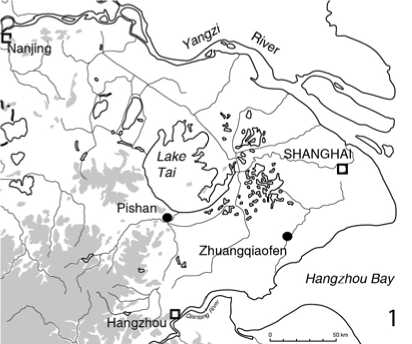
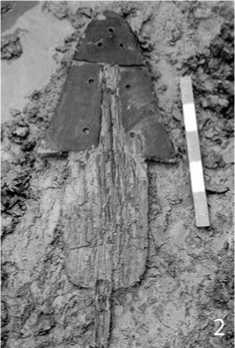
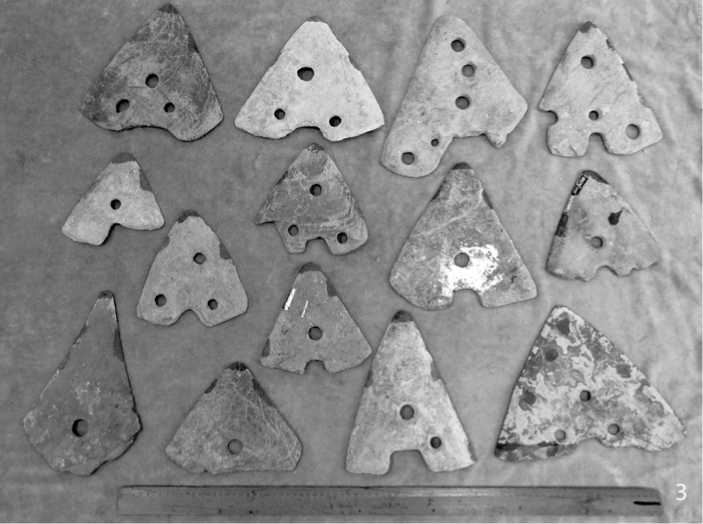
Fig. 1. Location of the sites and artifacts analyzed in this study: 1 – locations of Pishan and Zhuangqiaofen in the lower Yangzi River region; 2 – the “stone plow” found in Zhuangqiaofen (scale: 0.5 m); 3 – examples of stone plow-shaped implements from Pishan (scale: 1 m) (note that marks on the tip and lateral edges of the Pishan tools are the locations of PVS impressions taken)
plow-like stone implement attached to a wooden moldboard from the Zhuangqiaofen site (Pinghu City in Zhejiang) of the Liangzhu Culture has renewed researchers’ interest in the subject (Fig. 1). This find has been viewed as the hard evidence that proves such tools are plows [Xu Xinmin, Cheng Jie, 2005]. These functional interpretations, however, are only suggestive, because they are primarily based on the typology of the tools. The current project focuses on usewear traces observed on the plow-shaped tools excavated from the Pishan site in Huzhou City, Zhejiang, dated to the Songze culture, in order to provide reliable evidence for understanding the function of these tools.
We used Polyvinyl siloxane (PVS) impressions (or peels) to obtain usewear traces from the tool surfaces because the implements subject to study are large in size and difficult to examine under a microscope. Usewear patterns on stone tools using the same PVS method have been reported in various publications, demonstrating the effectiveness of this method [Dubreuil, 2004; Field, Fullagar, 1998; Fullagar, 1991; 2006]. We have also conducted experimental studies, which involved processing various plants and lithic materials with sandstones and slate to generate comparative reference data [Fullagar et al., in preparation; Liu et al., 2010a; 2010b; 2011]. These references are used for comparison with the usewear traces on the Pishan tools in this study.
Usewear traces were documented following examination of PVS peels using a Zeiss Scope A1 reflected-light microscope with magnifications of ×50, ×100, ×200 and/or ×500. The analytical usewear variables used in the current project are derived from previous studies as mentioned above, mainly including stages of polish development (low, medium and high), polish reticular pattern, striations (fine, wide, deep, and angular in cross-section), and surface micro-topography. The purpose of this research is to determine whether the Pishan triangular-shaped tools were used as plows; therefore, we pay special attention to the location of usewear traces on each tool and the orientations and types of striations.
Usewear traces on the modern iron plowshare
This iron plow was used for more than 10 years by farmers in Songxian, Henan, and striations and polish on the working surfaces are clearly visible with the naked eye. The upper side of the plowshare shows long and deep striations along the long axis, covering almost the entire body of the share. The front point on the lower side is severely worn down, forming an angular edge of 62º with deep and parallel striations perpendicular to the plow tip. This part of the tool apparently received the most impact from soil when plowing. The lateral edges are also heavily worn, with deep striations running diagonally to the working edge. The plowshare is slightly curved, with the tip bending down (Fig. 2, 1–4 ).
VPS peels were taken from the tip and lateral edges of the plowshare. Consistent with the visual observation, usewear traces taken from the plow surface appear massive under the microscope (with magnification of ×50), characterized by deep and wide striations revealed as angular in crosssection, as well as perpendicular to the plow point and diagonal to the lateral edges in their orientation (Fig. 2, 5 , 6 ).
The plowing experiment
A plow-shaped stone tool was used for the plowing experiment in Chifeng, Inner Mongolia. The tool (length: 32 cm; width: 15.5 cm) is made of dacite, which consists mostly of plagioclase feldspar (6 on the Mohs scale of hardness). For this experiment, the tool was hafted onto a wooden post, held by one person, and pulled with a rope by another person (Fig, 3, 1 , 2 ). The experimental plowing was conducted by the Chifeng Institute in 2010. After a few hours of plowing in the field, the tool surface became highly polished and striations were visible (Fig. 3, 3 , 4 ). Under the microscope can be seen long, deep, and angular striations with pecking marks, particularly evident on the back side of the plow tip, which received the most impact from soil during plowing, a phenomenon resembling the case of the iron plow. The upper side of the plow tip also shows long and deep striations with angular cross-section. The striations are perpendicular to the working edge of the tool, which is an orientation consistent with the movement of the plow (Fig. 3, 5 , 6 ). The usewear patterns on this tool are consistent with those on the modern iron plow, as described above.
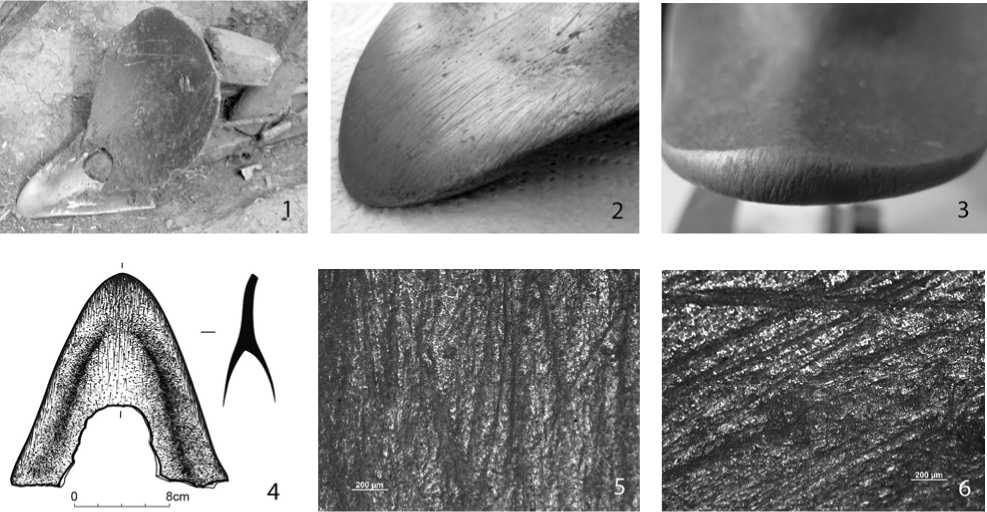
Fig. 2. A modern iron plow showing usewear traces: 1 – the iron plow; 2 – deep and long striations parallel to the long axis of the plowshare; 3 – heavily worn tip, viewed from the back side of the plowshare; 4 – the plan and profile of the plowshare; 5 and 6 – deep and wide striations, angular in cross-section, on the upper side of the front tip and the lateral side of the plowshare (×50)
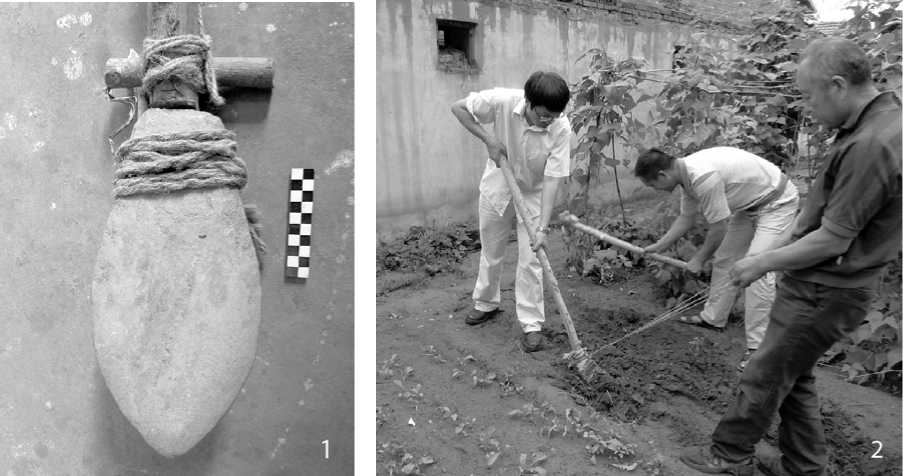
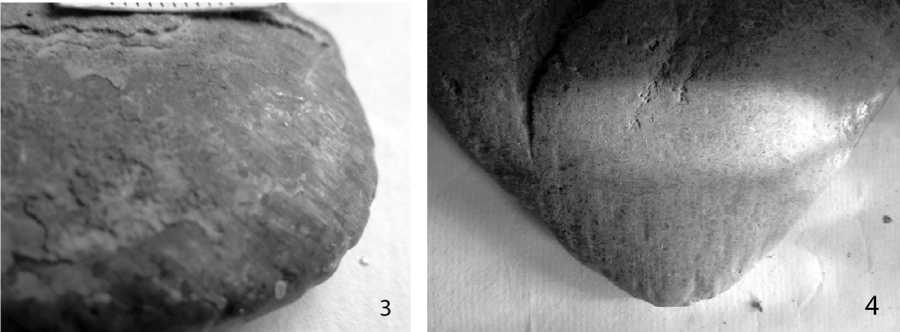
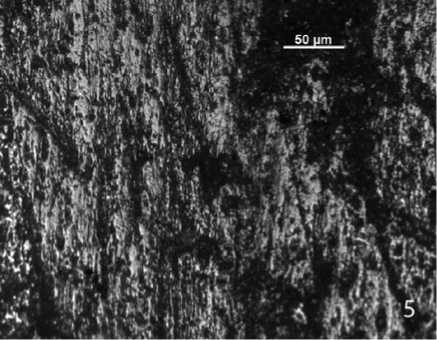
Fig. 3. The plowing experiment and usewear traces on the stone plow: 1 – the stone tool used in the plowing experiment; 2 – the plowing experiment; 3 – wide and deep striations visible on the back side of the plow tip; 4 – striations visible on the upper side of the plow tip; 5 – microscopic image of the back side of the plow tip, showing long and deep striations and pecking marks (×200); 6 – microscopic image of the upper side of the plow tip, showing long and deep striations (×200)
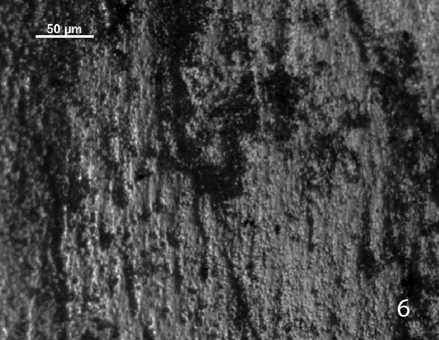

Fig. 4. Usewear patterns on a dolomite spade (broken) from Huizui: 1 – usewear traces visible on the tool edge (Side A); 2 – long and deep striations running perpendicular to the working edge on side A (×100); 3 – long striations running mul-ti-directionally on side B (×100)
Neolithic stone spade
To understand usewear patterns on soil-working tools other than a plow, we examined a dolominte (3.5–4 on the Mohs scale of hardness) stone spade (Fig. 4, 1 ) excavated from Huizui in Yanshi, Henan (the Longshan period). Huizui spades have been identified as a soil-working tool by an experimental study [Owen, 2007], and thus can be used here for comparison with the Pishan tools.
The spade has a chipped front edge, and striations perpendicular to the edge are clearly visible with the naked eye (Fig. 4, 1 ). Under the microscope, Side A has long, deep and angular striations perpendicular to the working edge, and Side B shows less developed striations running in multiple directions (Fig. 4, 2 , 3 ). Considering the shape of the spade, Side A appears to have been facing down when the tool was in use, and therefore it has more developed usewear than Side B.
On the basis of the above observations regarding the three reference tools, we conclude that six diagnostic characteristics can be used for identifying ancient plows.
-
1. In general, a stone plow is a heavy-duty implement and should be made with a robust morphology; it does not need sharp lateral edges and its front tip should be strong enough to sustain impact from soil breaking; and it should show clear striations on its surfaces, visible to the naked eye, regardless the hardness of the lithic material.
-
2. The upper side of the entire plowshare should show long and deep striations running parallel to the long axis of the tool, consistent with the orientation of the plowing motion.
-
3. The tip and lateral edges of the plowshare should show use damage, such as heavy wear with striations on the edges; the orientation of the striations should be consistent with the plowing motion, i. e. transverse on the tip but diagonal on the lateral edges.
-
4. The upper side of the share body should show more usewear than the lower side, because the upper side is subjected to impact against the soil when plowing.
-
5. The plowing motion should create an angled tip displaying the most intense wear, characterized by wide, deep, and angular striations on the lower side of the tip.
-
6. A major difference between plow and spade is that striations on a plow are mainly monodirectional, in accord with the consistent plowing motion, whereas striations on a spade may be multi-directional, due to irregular movements when digging, shoveling, or tilling soil.
Although these tools were used in northern China’s dry-land plowing, the movement of a plow in any soil types would produce similar usewear traces, particularly in terms of the orientation of striations. These diagnostic characteristics, therefore, are used to examine the Pishan stone tools as follows.
Usewear analysis of the Pishan tools
The Pishan site yielded 22 triangular-shaped stone tools, all made of hornfels. They were mostly unearthed from burials (21), and identified as plows or proto-plows in the excavation report [The site…, 2006. P. 452–455].
PVS impressions (or peels) were taken from the tip and lateral edges of each tool, and in some cases peels were also taken from the central areas of the tool body. Here we report the results from five tools. Based on the usewear patterns, the five tools can be divided into two groups: (1) tools used on plant materials only (Tools 1–3); and (2) tools used on materials that include both soil and plants (Tools 4, 5).
Pishan Tool 1 ( HPI_M1-5 )
This tool (length: 18.5 cm; width: 17.5 cm; thickness: 1.4 cm) has three perforations on the body and a notch at the end. The front hole is off-center, a condition suggesting that the hafting may have been acentric (Fig. 5, 1 , 2 ). Side A was modified to form sharp edges, whereas Side B shows rough surface with no usewear traces and probably was originally attached to an object.
Peel 1 (from the tip) shows large areas of high-level polish and parallel striations. Striations are mostly fine and short, running in various directions, from nearly horizontal to 45 degree diagonal (Fig. 5, 3 , 4 ). Peel 2 (from the left lateral edge) shows fine and short striations running parallel and diagonal to the working edge (Fig. 4, 5 ), suggesting a slicing motion. Peel 3 was taken from the right lateral edge, showing no clear usewear trace.
This tool appears to have been used as a knife with a slicing action on one lateral-edge, but the tip was used in both transverse and slicing motions. These actions are inconsistent with that of a plow. The very fine striations only become visible under magnifications of ×200 or higher, and such striations differ significantly from those seen on soil-working tools from our references. The presence of large polished areas and very fine striations is characteristic of tools used for processing plants, as found in our reference examples cited above.
Pishan Tool 2 ( O4HPIM40:11 )
This implement (length: 24.2 cm; width: 19.8 cm; thickness: 1.5 cm) has two perforations on the right side of the body and a notch at the end, suggesting that the hafting was acentric. Both surfaces are smooth, and the lateral edges are sharp. Three peels taken from the tip and lateral edges were analyzed (Fig. 6, 1 ).
On Side A of Peel 1 (from the tip), diagonal fine striations only appear at a few spots, whereas on Side B striations are widely distributed, running nearly horizontally to the tip (Fig. 6, 2 , 3 ). Peel 2 and Peel 3 were taken from the lateral edges, showing few clear usewear traces. Only under high magnification of ×500 does an isolated small area of short striations running multi-directionally become visible on Side B of Peel 3, but it is unclear whether these traces are related to the tool’s actual use (Fig. 6, 4 ).
This tool seems to have been used mainly on the tip with various working actions; the lack of usewear traces on its lateral edges indicates that those parts of the tool were probably so infrequently used that little visible usewear was formed. The striations are much finer than those on the experimental soil-working tools, but similar to plant processing implements in our references. These patterns are apparently inconsistent with the characteristics of a plow.
Pishan Tool 3 ( M41-2 )
This tool (length: 17.5 cm; width: 18.3 cm; thickness: 1.2 cm) has one perforation near the center, and both sides have smooth surface with no visible usewear trace. PVS peels were taken from the tip, the left lateral edge, and a location near the center (Fig. 7, 1 ).
Peel 1 (from the tip) shows reticulate areas of high-level polish with or without striations on both Side A and Side B (Fig. 7, 2–4 ). When striations are present, they mostly run perpendicular to the tip. The striations are fine and short, only becoming clearly visible under magnifications
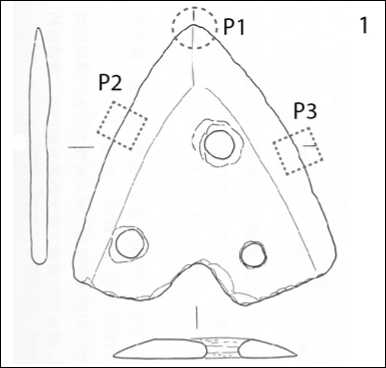
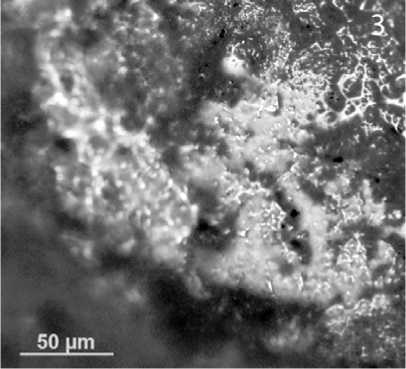
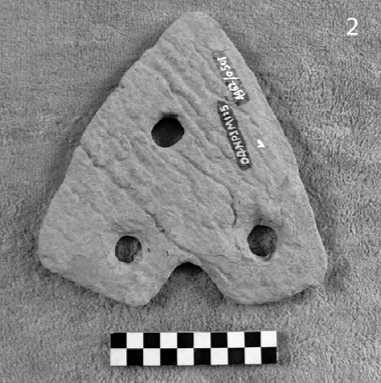
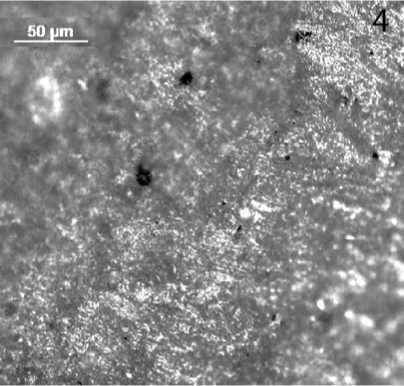
Fig. 5. Pishan Tool 1, the location of VPS peels, and usewear patterns: 1 , 2 – Tool 1 (Side A and B); 3 – polished areas on the tip (Peel 1, Side A); 4 – fine and short striations running multi-directionally on the tip (Peel 1, Side A); 5 – fine and short striations parallel to the left lateral edge (Peel 2, Side A) (×200)
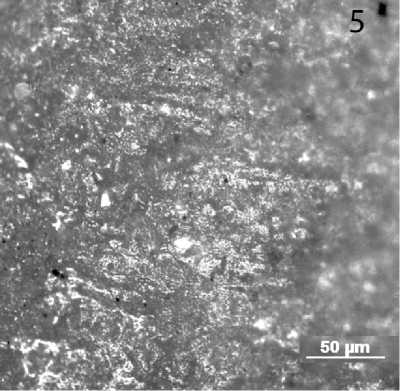
of ×500 (Fig. 7, 4 ). Such type of striation and high polish are similar to usewear traces on siliceous plant-processing tools in our reference set. Peel 2 (from the left lateral edge) shows faint striations parallel to the working edge, particularly visible on Side A, indicating a slicing motion (Fig. 7, 5 ); there is a small area on Side B where wide multi-directional striations are present, but it is difficult to assess whether they are tool-use related (Fig. 7, 6 ). Peel 3 (from an area near the tool center) shows no usewear trace.
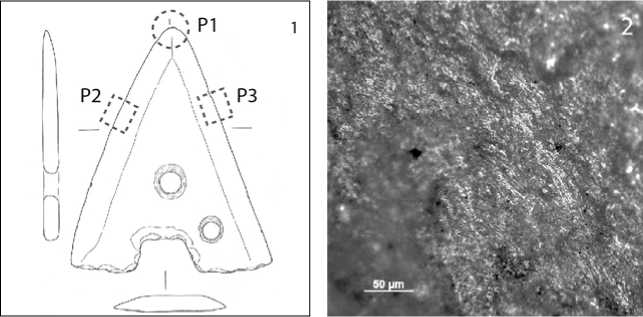
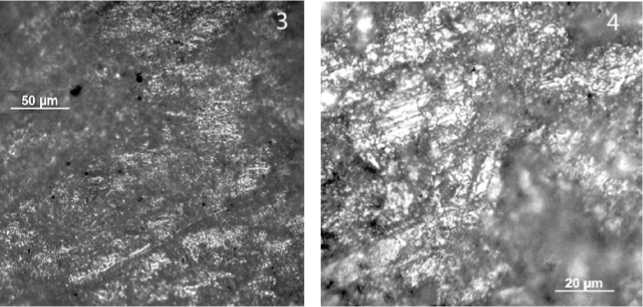
Fig. 6. Pishan Tool 2, showing the location of PVS peels and usewear patterns: 1 – Tool 2 (Side A); 2 – fine and long striations diagonal to the tip (Peel 1, Side A; ×200); 3 – fine and short striations running horizontally to the tip (Peel 1, Side B; ×200); 4 – medium-level polish with angular striations on the right lateral edge, multi-directional to the edge (Peel 3, Side B; ×500)

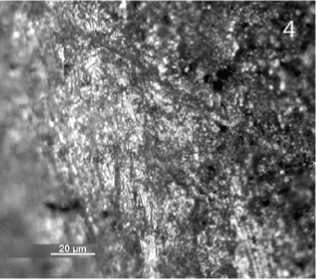


Fig. 7. Pishan Tool 3, showing location of the PVS peels and usewear patterns: 1 – Tool 3 (Side A); 2 , 3 – highly polished areas on both sides of the tool tip (Peel 1, Side A and Side B; ×500); 4 – fine striations perpendicular and diagonal to the tip (Peel 1, Side B; ×500); 5 – faint striations running horizontally to the left lateral edge (Peel 2, Side A; ×200); 6 – striations running vertically and horizontally to the left lateral edge (Peel 2, Side B; ×200)


Fig. 8. Pishan Tool 4, showing the location of PVS peels and usewear patterns: 1 – Pishan Tool 4 (Side A); 2 , 3 – reticulate polish and striations running multi-directionally on the tip (Peel 1, Side A; ×200 and ×500); 4 , 5 – reticulate polish and striations running mostly diagonal on the tip (Peel 1, Side B; ×200 and ×500); 6 – fine striations running horizontally to the left lateral edge (Peel 3, Side A; magnification: ×200)

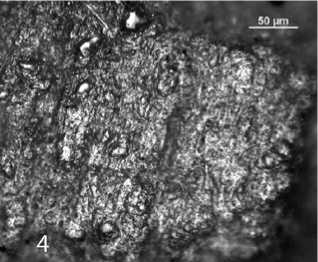
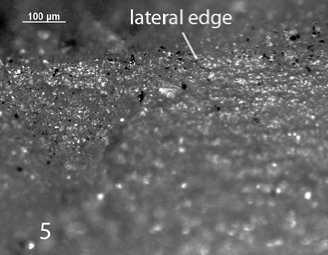

Fig. 9. Pishan Tool 5, showing location of PVS and usewear patterns: 1 – Tool 5 (Side A); 2 – medium level polish with no visible striation on the tip (Peel 1, Side A; ×200); 3 – long striations diagonal to the tip (Peel 1, Side B; ×200); 4 – vertical striations on the tip (Peel 1, Side B; ×200); 5 – striations parallel to the left lateral edge (Peel 2, Side A; ×100); 6 – striations vertical on the right lateral edge, but horizontal below it (Peel 3, Side B; ×200)
shows long striations nearly parallel to the working edge, indicating a slicing motion (Fig. 8, 6 ). Peel 4 shows no clear usewear.
The usewear traces suggest that the tip and the long lateral edge were used for different tasks. The tip may have been used for digging fine soil, like a spade. The edge on the longer side was used in a slicing motion as a knife on soft materials, such as plants, but the short lateral edge was rarely used. These patterns differ completely from those typical of a plow.
Pishan Tool 5 ( M11-4 )
This tool (length: 23 cm; width: 24 cm; thickness: 1.5 cm) has three perforations on the body. Side A has a smooth surface with no usewear traces visible, and Side B is covered with sediment, precluding detailed visual examination. Peels were taken from the tip and two lateral edges (Fig. 9, 1 ).
Peel 1 (from the tip) shows medium-level polished areas without clearly visible striations on Side A, but abundant striations on Side B. These striations are long and deep, angular in crosssection, and running diagonally or vertically to the tip (Fig. 9, 2–4 ). These traces quite resemble the usewear patterns from soil-working tools in our references. Peel 2 (from the left lateral edge) shows some barely visible striations running horizontally near the edge, suggesting that it was used in a slicing motion as a knife (Fig. 9, 5 ). Peel 3 (from the right lateral edge) shows very fine, transverse striations on the edge, but horizontal striations are visible in areas below the edge on both sides, indicating that this edge was used as a knife as well as a scraper (Fig. 9, 6 ).
The presence of various usewear types and different orientations of striations suggests that this was a multi-tasking tool. It may have been used as a digging tool, a knife, and a scraper. It appears to have worked on various materials, probably including fine-grained soil and plants. The usewear patterns are inconsistent with those from a plow.
Discussion and conclusions
Morphologically, none of the Pishan tools has an angled front tip such as caused by breaking soil when plowing. All Pishan tools have sharp lateral cutting edges which are unnecessary for a plow. In addition, none of them shows visible striations on the surface similar to the soil-working tools.
Microscopically, in all five samples examined, the tips appear to have been used in various working motions. This was inferred from the presence of multi-directional striations. This pattern is similar to those on the spade, as discussed above. In four cases (#1, 3, 4, 5), lateral edges were used in a slicing motion, like a knife. In one case the tool was also used for scraping (#5), as inferred from the presence of perpendicular striations on one lateral edge. In all cases the front tip appears to have been used independently of the lateral edges. The presence of high-level polished areas and very fine and short striations on Tools #1–3 indicates that they were used in tasks involving plants. Only two tools (# 4, 5) were probably used on fine soil or other hard objects, as judged from the presence of angular striations; but only a limited area on the tip was used for this purpose. These soil-working tools, however, were also used for processing plants, as suggested by the presence of fine striations.
In summary, the Pishan tools examined are multi-tasking implements, used as spades, knives and scrapers. They appear to have been used on various materials, including plants and fine-grained soil, but none of them shows usewear traces resembling a plow. This result does not support the claim that these Neolithic triangular-shaped stone implements were plows, so we question the assumption that Neolithic rice paddies were prepared with stone plows. The exact functions of these tools are currently unclear, but they are likely to have been used as all-purpose tools (excluding plowing). Different tasks performed in the last use of these tools would have left various usewear traces, which are observable today. Given that the area surrounding the Pishan site had abundant water bodies in the Neolithic times [Zheng Yunfei, Chen Xugao, 2006], it is possible that these tools were used in tasks involving collecting aquatic plants in rivers, lakes, or swamps. In order to further understand the tool functions, we need to conduct experimental studies, using replicated plow-shaped tools made of hornfels to perform various tasks, and analyzing the usewear patterns to make comparisons with the ancient tools.
This study also demonstrates that usewear analysis and experimental study are powerful methods for investigating stone tool functions that have been customarily inferred from typology in the past. The usewear patterns of soil-working tools generated from this project provide a new database for functional study of similar stone tools in the future.
Acknowledgements
We thank Chen Yun for helping with taking usewear samples from the plow-shaped tools at the Huzhou City Museum. We are grateful for the generous assistance provided by Liu Guoxiang, Wang Ruichang, Wang Dongfeng, Zhang Kecheng, and Wang Zhixian for conducting the plow experiment in Chifeng, Inner Mongolia.

